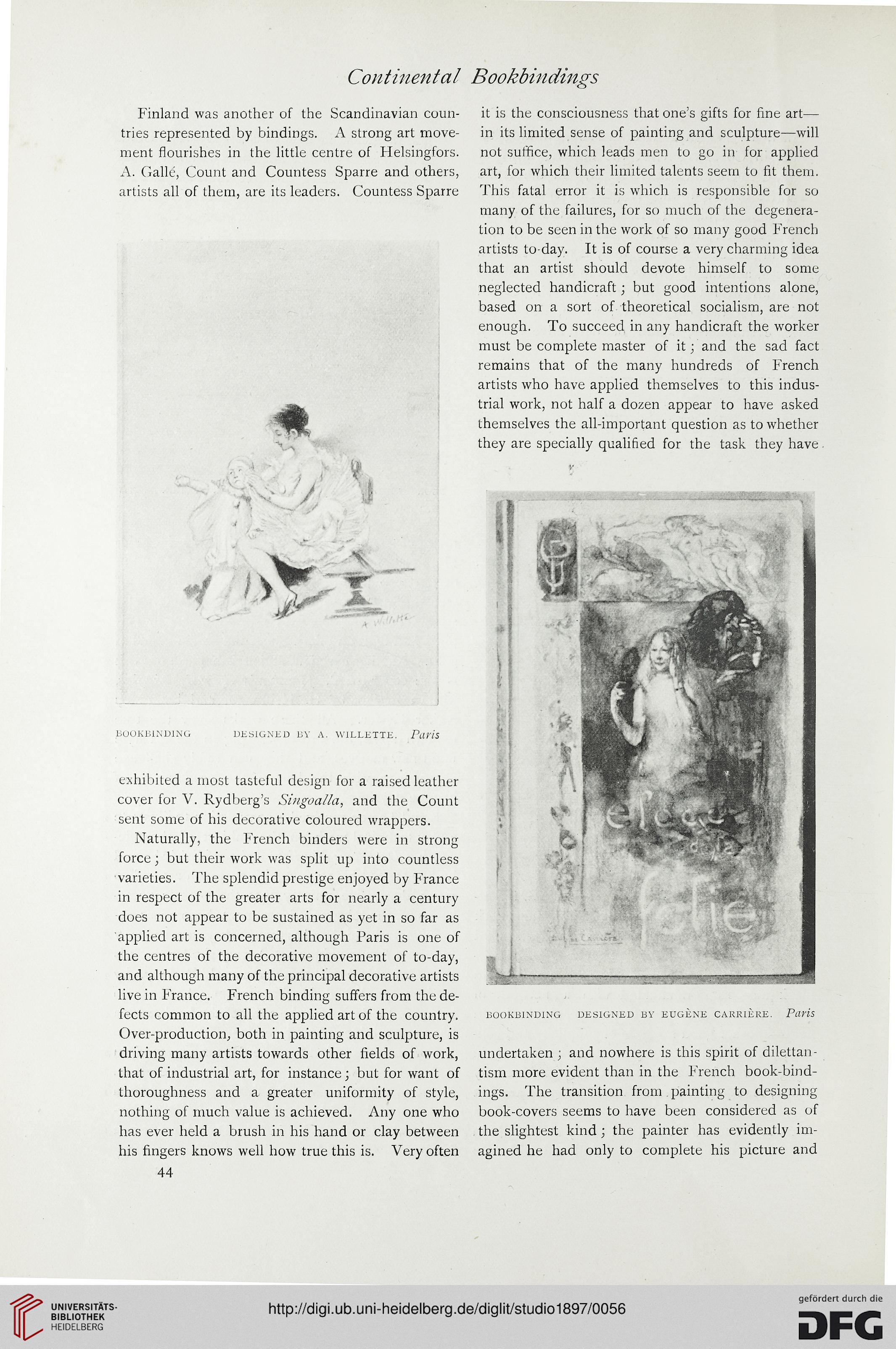Continental Bookbindings
Finland was another of the Scandinavian coun-
tries represented by bindings. A strong art move-
ment flourishes in the little centre of Helsingfors.
A. Galle, Count and Countess Sparre and others,
artists all of them, are its leaders. Countess Sparre
BOOKBINDING DESIGNED BY A. WILLETTE. Paris
exhibited a most tasteful design for a raised leather
cover for V. Rydberg's Singoalla, and the Count
sent some of his decorative coloured wrappers.
Naturally, the French binders were in strong
force; but their work was split up into countless
varieties. The splendid prestige enjoyed by France
in respect of the greater arts for nearly a century
does not appear to be sustained as yet in so far as
applied art is concerned, although Paris is one of
the centres of the decorative movement of to-day,
and although many of the principal decorative artists
live in France. French binding suffers from the de-
fects common to all the applied art of the country.
Over-production, both in painting and sculpture, is
driving many artists towards other fields of work,
that of industrial art, for instance; but for want of
thoroughness and a greater uniformity of style,
nothing of much value is achieved. Any one who
has ever held a brush in his hand or clay between
his fingers knows well how true this is. Very often
44
it is the consciousness that one's gifts for fine art—
in its limited sense of painting and sculpture—will
not suffice, which leads men to go in for applied
art, for which their limited talents seem to fit them.
This fatal error it is which is responsible for so
many of the failures, for so much of the degenera-
tion to be seen in the work of so many good French
artists to-day. It is of course a very charming idea
that an artist should devote himself to some
neglected handicraft; but good intentions alone,
based on a sort of theoretical socialism, are not
enough. To succeed in any handicraft the worker
must be complete master of it; and the sad fact
remains that of the many hundreds of French
artists who have applied themselves to this indus-
trial work, not half a dozen appear to have asked
themselves the all-important question as to whether
they are specially qualified for the task they have.
BOOKBINDING DESIGNED BY EUGENE CARR1ERE. PllVtS
undertaken ; and nowhere is this spirit of dilettan-
tism more evident than in the French book-bind-
ings. The transition from painting to designing
book-covers seems to have been considered as of
the slightest kind; the painter has evidently im-
agined he had only to complete his picture and
Finland was another of the Scandinavian coun-
tries represented by bindings. A strong art move-
ment flourishes in the little centre of Helsingfors.
A. Galle, Count and Countess Sparre and others,
artists all of them, are its leaders. Countess Sparre
BOOKBINDING DESIGNED BY A. WILLETTE. Paris
exhibited a most tasteful design for a raised leather
cover for V. Rydberg's Singoalla, and the Count
sent some of his decorative coloured wrappers.
Naturally, the French binders were in strong
force; but their work was split up into countless
varieties. The splendid prestige enjoyed by France
in respect of the greater arts for nearly a century
does not appear to be sustained as yet in so far as
applied art is concerned, although Paris is one of
the centres of the decorative movement of to-day,
and although many of the principal decorative artists
live in France. French binding suffers from the de-
fects common to all the applied art of the country.
Over-production, both in painting and sculpture, is
driving many artists towards other fields of work,
that of industrial art, for instance; but for want of
thoroughness and a greater uniformity of style,
nothing of much value is achieved. Any one who
has ever held a brush in his hand or clay between
his fingers knows well how true this is. Very often
44
it is the consciousness that one's gifts for fine art—
in its limited sense of painting and sculpture—will
not suffice, which leads men to go in for applied
art, for which their limited talents seem to fit them.
This fatal error it is which is responsible for so
many of the failures, for so much of the degenera-
tion to be seen in the work of so many good French
artists to-day. It is of course a very charming idea
that an artist should devote himself to some
neglected handicraft; but good intentions alone,
based on a sort of theoretical socialism, are not
enough. To succeed in any handicraft the worker
must be complete master of it; and the sad fact
remains that of the many hundreds of French
artists who have applied themselves to this indus-
trial work, not half a dozen appear to have asked
themselves the all-important question as to whether
they are specially qualified for the task they have.
BOOKBINDING DESIGNED BY EUGENE CARR1ERE. PllVtS
undertaken ; and nowhere is this spirit of dilettan-
tism more evident than in the French book-bind-
ings. The transition from painting to designing
book-covers seems to have been considered as of
the slightest kind; the painter has evidently im-
agined he had only to complete his picture and




